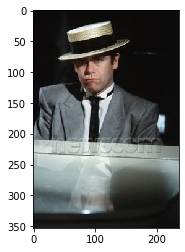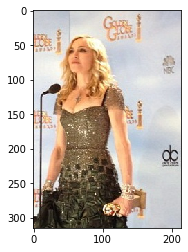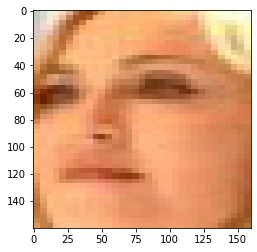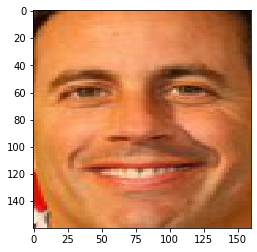机器学习20:基于ResNet50和FaceNet实现人脸识别
说明:这是优达学城的一个机器学习作业项目,我觉得还比较典型综合了几个常见的深度学习技术,值得分享一下;实现包括,数据增广,迁移学习,网络模型构建,训练,评估方法等。缺点:由于训练数据集规模较小,训练的数据,不确定精确反映网络模型性能;比如ResNet50加载预训练模型权重,相比不加载(随机值),训练后精确度反而稍微较低,与理论不符。项目3:人脸识别欢迎来到机器学习工程师纳米学位的第三个项...
说明:
这是优达学城的一个机器学习作业项目,
我觉得还比较典型综合了几个常见的深度学习技术,值得分享一下;实现包括,数据增广,迁移学习,网络模型构建,训练,评估方法等。
这里只是做了一个迁移学习的实现,重在实践过程,其原理没做分析。
缺点:由于训练数据集规模较小,训练的数据,不确定精确反映网络模型性能;比如ResNet50加载预训练模型权重,相比不加载(随机值),训练后精确度反而稍微较低,与理论不符。
项目3:人脸识别
欢迎来到机器学习工程师纳米学位的第三个项目!在此文件中,有些示例代码已经提供给你,但你还需要实现更多的功能让项目成功运行。除非有明确要求,你无须修改任何已给出的代码。每一部分都会有详细的指导,需要实现的部分也会在注释中以’TODO’标出。请仔细阅读所有的提示!
除了实现代码外,你还必须回答一些与项目和你的实现有关的问题。每一个需要你回答的问题都会以’问题 X’为标题。请仔细阅读每个问题,并且在问题后的’回答问题’文字框中写出完整的答案。我们将根据你对问题的回答和撰写代码所实现的功能来对你提交的项目进行评分。
任务介绍
人脸识别是一个计算机视觉任务,任务是要通过一张带有人脸的图像,对图像中的人脸进行识别并判断是谁。关于人脸识别的任务,我们一定会用到2015年Google开发的FaceNet,这个模型由于其性能非常好而被广泛使用,并且该训练好的模型已经被开源。
因此,本项目的任务将要学习人脸识别任务,在此项目中,我们将先按课程所学到的知识亲手搭建一个卷积神经网络,然后,我们将用高级的网络结构,比如ResNet50再次进行人脸识别任务,最后我们将用到预训练好的FaceNet模型。在这个过程中,我们还会用到数据增强和人脸抽取技术来提升人脸识别的精确度。
在这个人脸识别项目中,我们将使用一个开源数据集Five Celebrity Faces Dataset,这也是一个在Kaggle比赛中的一个数据集。我们也已经下载好了并放在./5-celebrity-faces-dataset中,数据集中包含五位名人的照片,Ben Affleck, Elton John, Jerry Seinfeld, Madonna, Mindy Kaling。文件下分train和val。
数据准备
我们首先要简单的观察数据,然后通过数据增强和人脸抽取技术对数据图像数据进行抽取。你需要在完成这些操作后,思考并回答相关的问题。
显示一张图像
所有 train下面的图像文件名都存入 images 列表中,并将该图像的人名按顺序存于 images_name 中
import cv2
import matplotlib.pyplot as plt
import os
import random
import pandas as pd
%matplotlib inline
data_root = "./5-celebrity-faces-dataset/train/"
import csv
def read_file_log(pathName, cvsName):
with open(cvsName, 'w',encoding='utf-8') as f_cvs:
csv_writer = csv.writer(f_cvs)
#csv_writer.writerow(['fileNale', 'label'])
#csv_writer.writerow(["file_path", "name"])
all_dirs = os.listdir(pathName)
for dir_name in all_dirs:
all_files = os.listdir(pathName+dir_name)
for file_name in all_files:
child = os.path.join('%s/%s/%s' % (pathName, dir_name,file_name))
label = dir_name
##print child.decode('gbk') # .decode('gbk')是解决中文显示乱码问题
#print(child,label)
csv_writer.writerow([child, label])
train_log_file = './5-celebrity-faces-dataset/train_log.csv'
read_file_log(data_root,train_log_file)
def read_csv(file):
with open(file) as csvfile:
reader = csv.reader(csvfile)
images = []
images_name = []
for line in reader:
images.append(line[0])
images_name.append(line[1])
return images,images_name
# TODO: 把所有 train下面的图像文件名都存入 images 列表中,并将该图像的人名按顺序存于 images_name 中
images,images_name = read_csv(train_log_file)
print(images[0])
print(images_name[0])
./5-celebrity-faces-dataset/train//elton_john/httpssmediacacheakpinimgcomxfefdacfbfdeadajpg.jpg
elton_john
从images中随机读取一张图像,使用 cv2.imread读取图像,然后使用pyplot.imshow显示图像。注意:你需要同时显示该图像对应的人名,以及打印该图像的shape。
# TODO: 从images 中随机读取一张图像,并获得该图像中的人名
from random import randrange
def random_sample(images=images, images_name=images_name):
print("随机选取一张照片:")
random_index = randrange(0,len(images))
# TODO:从 images 和 images_name 随机读取一个图像文件路径以及该图像的人名
im_file, im_name = images[random_index],images_name[random_index]
# TODO:使用 cv2.imread 读取图像文件
img = cv2.imread(im_file)
img2=cv2.cvtColor(img, cv2.COLOR_BGR2RGB) # cv2默认为bgr顺序
# TODO:使用 plt.imshow 和 plt.show() 显示图像
plt.imshow(img2)
plt.show()
# 打印该图像的人名
print(im_name)
# 打印该图像的大小 shape
print(img.shape)
return im_file, im_name
random_sample(images, images_name)
随机选取一张照片:

elton_john
(353, 236, 3)
('./5-celebrity-faces-dataset/train//elton_john/httpssmediacacheakpinimgcomxfefdacfbfdeadajpg.jpg',
'elton_john')
你可以多次运行上面的代码来多观察一些人物图像,以此来对数据有一个大致的认知
用cv2.imread读取所有数据并存入train_x中,然后用 0,1,2,3,4 来标记 Ben Affleck, Elton John, Jerry Seinfeld, Madonna, Mindy Kaling,并将所有images_name数据存入train_y中。
train_x = []
train_y = []
dict_name = {'ben_afflek':0,
'elton_john':1,
'jerry_seinfeld':2,
'madonna':3,
'mindy_kaling':4}
for file,name in zip(images,images_name):
#print(file,name)
train_x.append(cv2.imread(file))
train_y.append(dict_name[name])
print(train_y)
[1, 1, 1, 1, 1, 1, 1, 1, 1, 1, 1, 1, 1, 1, 1, 1, 1, 0, 0, 0, 0, 0, 0, 0, 0, 0, 0, 0, 0, 0, 0, 2, 2, 2, 2, 2, 2, 2, 2, 2, 2, 2, 2, 2, 2, 2, 2, 2, 2, 2, 2, 2, 3, 3, 3, 3, 3, 3, 3, 3, 3, 3, 3, 3, 3, 3, 3, 3, 3, 3, 3, 4, 4, 4, 4, 4, 4, 4, 4, 4, 4, 4, 4, 4, 4, 4, 4, 4, 4, 4, 4, 4, 4]
数据增强
首先,我们需要打印训练集的数量。
print(len(images))
93
我们可以看到,训练集的图像数量比较少,这对模型建模并学习图像数据到人名标签的映射关系增加了难度,所以这里需要做数据增强的工作。这里有一份很不错的资料可以帮助你了解数据增强——Data Augmentation。
from keras.preprocessing.image import ImageDataGenerator
# TODO: 构造图像数据增强器
data_gen = ImageDataGenerator(
rescale = .1, # TODO:随机缩放图像RGB值的倍数
rotation_range =0.15 , # TODO:随机旋转图像的范围
zoom_range = 0.1, # TODO:随机缩放图像大小范围
width_shift_range = 0.2, # TODO:随机水平方向平移图像(fraction of total width)
height_shift_range= 0.2, # TODO:随机纵向平移图像(fraction of total height)
horizontal_flip=True,
)
Using TensorFlow backend.
使用 flow_from_directory 遍历数据集 ./5-celebrity-faces-dataset/data,来观察数据增强的表现。先得到一个图像迭代器,该迭代器每次都从路径里读取一个图像,并按照数据增强器的规则进行编辑图像
# 直接运行,得到一个图像迭代器,该迭代器每次都从路径里读取一个图像,并按照数据增强器的规则进行编辑图像
dataflow_generator = data_gen.flow_from_directory(
"./5-celebrity-faces-dataset/data",
target_size=(160, 160),
batch_size=3,
color_mode='rgb',
class_mode='categorical')
print(dataflow_generator.filenames)
Found 5 images belonging to 5 classes.
['ben_afflek/httpcsvkmeuaeccjpg.jpg', 'elton_john/httpftqncomymusicLxZeltonjohnjpg.jpg', 'jerry_seinfeld/httpgraphicsnytimescomimagessectionmoviesfilmographyWireImagejpg.jpg', 'madonna/httpiamediaimdbcomimagesMMVBMTANDQNTAxNDVeQTJeQWpwZBbWUMDIMjQOTYVUXCRALjpg.jpg', 'mindy_kaling/httpgonetworthcomwpcontentuploadsthumbsjpg.jpg']
# TODO:从 迭代器中 读取10张图片,并显示图像
from keras.preprocessing.image import array_to_img
sample_count = 10
i = 0
filenames = dataflow_generator.filenames
labels = dataflow_generator.class_indices
print(filenames)
print(len(filenames))
print(labels)
#此处image_data是一个二维序列,
#image_data[0][...]存放batch_size张图片
#image_data[1][...]存放batch_size对应标签
for image_data in dataflow_generator:
# TODO:使用 plt.imshow 和 plt.show() 显示图像
print(len(image_data[1]))
for j in range(0,len(image_data[1])):
if i >= 12:
break
plt.subplot(3,5,1+i)
image = image_data[0][j].astype('uint8')
#print(type(image_data))
plt.imshow(array_to_img(image))
#plt.imshow(image)
i += 1
print(image_data[1][j]) #label
print(image_data[0][0].shape) #image
sample_count -= 1
if sample_count <= 0:
break
['ben_afflek/httpcsvkmeuaeccjpg.jpg', 'elton_john/httpftqncomymusicLxZeltonjohnjpg.jpg', 'jerry_seinfeld/httpgraphicsnytimescomimagessectionmoviesfilmographyWireImagejpg.jpg', 'madonna/httpiamediaimdbcomimagesMMVBMTANDQNTAxNDVeQTJeQWpwZBbWUMDIMjQOTYVUXCRALjpg.jpg', 'mindy_kaling/httpgonetworthcomwpcontentuploadsthumbsjpg.jpg']
5
{'ben_afflek': 0, 'elton_john': 1, 'jerry_seinfeld': 2, 'madonna': 3, 'mindy_kaling': 4}
3
[0. 0. 0. 0. 1.]
(160, 160, 3)
[0. 1. 0. 0. 0.]
(160, 160, 3)
[0. 0. 1. 0. 0.]
(160, 160, 3)
2
[0. 0. 0. 1. 0.]
(160, 160, 3)
[1. 0. 0. 0. 0.]
(160, 160, 3)
3
[0. 0. 0. 1. 0.]
(160, 160, 3)
[0. 0. 0. 0. 1.]
(160, 160, 3)
[0. 1. 0. 0. 0.]
(160, 160, 3)
2
[0. 0. 1. 0. 0.]
(160, 160, 3)
[1. 0. 0. 0. 0.]
(160, 160, 3)
3
[0. 0. 1. 0. 0.]
(160, 160, 3)
[0. 0. 0. 1. 0.]
(160, 160, 3)
2
3
2
3
2

问题1:观察以上人脸图像,简单说说产生的图像中存在哪些增强的部分,然后再详细阐述你对数据增强的思考,包括为什么数据增强能够帮助人脸识别?你需要参考一些论文,并列出你的引用。
问题回答:
左右平移,上下平移,旋转
用CNN处理图片特征,具有平移不变形,旋转不变性。
因为对同一个人拍照,可以采取不同角度和构图,所以做数据增强可以更好泛化
数据增强能够补充数据数量,防止过拟合,增强模型的泛化能力。数据增强有助于产生更多的数据训练网络。增强模型的泛化的性能,使网络能够泛化到不在训练集中的图像。正如本项目的训练集的图像数量比较少,模型建模并学习就很困难。通过数据增强的方式,就可以在很少数据情况下产生足够多的数据,建立图片分类器。
增强模型的泛化的性能,一般的手段有数据增强和正则化方法,而用于数据增强的一般方法有:随机裁剪、随机水平翻转、平移、旋转、增加噪音和生成网络方法等(前两个方法用的最多,也最有效)。
人脸抽取
在做人脸识别任务中,一项常用的图像数据处理的技术是人脸检测(Face Detection)。人脸检测是将输入的图片中的人脸部分自动检测出来,具体来说就是要通过预测一个矩形边界框(Bounding Box)从整个图像中定位人脸部分,这里的矩形边界框由矩形左下角坐标以及矩形高和宽来定义。人脸检测是一个比较成熟的任务,接下来在我们这个项目中,我们将使用 Multi-Task Cascaded Convolutional Neural Network,MTCNN,你也可以参考论文:Joint Face Detection and Alignment Using Multitask Cascaded Convolutional Networks,来学习人脸检测任务。
# 运行下面代码,安装 mtcnn
!pip install mtcnn
Requirement already satisfied: mtcnn in /home/leon/anaconda3/lib/python3.7/site-packages (0.1.0)
Requirement already satisfied: keras>=2.0.0 in /home/leon/anaconda3/lib/python3.7/site-packages (from mtcnn) (2.3.1)
Requirement already satisfied: opencv-python>=4.1.0 in /home/leon/anaconda3/lib/python3.7/site-packages (from mtcnn) (4.2.0.32)
Requirement already satisfied: keras-applications>=1.0.6 in /home/leon/anaconda3/lib/python3.7/site-packages (from keras>=2.0.0->mtcnn) (1.0.8)
Requirement already satisfied: keras-preprocessing>=1.0.5 in /home/leon/anaconda3/lib/python3.7/site-packages (from keras>=2.0.0->mtcnn) (1.1.0)
Requirement already satisfied: six>=1.9.0 in /home/leon/anaconda3/lib/python3.7/site-packages (from keras>=2.0.0->mtcnn) (1.13.0)
Requirement already satisfied: pyyaml in /home/leon/anaconda3/lib/python3.7/site-packages (from keras>=2.0.0->mtcnn) (5.2)
Requirement already satisfied: h5py in /home/leon/anaconda3/lib/python3.7/site-packages (from keras>=2.0.0->mtcnn) (2.8.0)
Requirement already satisfied: scipy>=0.14 in /home/leon/anaconda3/lib/python3.7/site-packages (from keras>=2.0.0->mtcnn) (1.3.2)
Requirement already satisfied: numpy>=1.9.1 in /home/leon/anaconda3/lib/python3.7/site-packages (from keras>=2.0.0->mtcnn) (1.17.4)
# 定义人脸抽取的函数
from PIL import Image
from mtcnn.mtcnn import MTCNN
import numpy as np
def extract_face(filename, image_size=(160, 160)):
# 加载图像
image = Image.open(filename)
# 转换RGB
image = image.convert('RGB')
# 转成 numpy.array 格式的数据
image_data = np.asarray(image)
# 创建一个人脸检测,
detector = MTCNN()
# 从图像中检测
results = detector.detect_faces(image_data)
# 返回的结果是图像中所有出现的人脸的矩形边界框,由于我们的图像中只有一张人脸,所所以只需要取结果中第一个
box_x, box_y, width, height = results[0]['box']
# 处理下标为负的情况
box_x, box_y = abs(box_x), abs(box_y)
box_x_up, box_y_up = box_x + width, box_y + height
# 获得人脸部分的数据
face = image_data[box_y:box_y_up, box_x:box_x_up]
print("face.shape",face.shape)
# TODO:把抽取出来的人脸图像 resize 至需要的图像大小,并返回numpy格式的数据
#face_array = cv2.resize(face,image_size,interpolation=cv2.INTER_CUBIC)
image = Image.fromarray(face)
image = image.resize(image_size)
face_array = np.asarray(image)
return face_array
ran_img_file, ran_img_name = random_sample()
img = extract_face(ran_img_file)
plt.imshow(img)
#plt.show()
print(img.shape)
随机选取一张照片:

madonna
(315, 214, 3)
WARNING:tensorflow:From /home/leon/anaconda3/lib/python3.7/site-packages/keras/backend/tensorflow_backend.py:4070: The name tf.nn.max_pool is deprecated. Please use tf.nn.max_pool2d instead.
WARNING:tensorflow:From /home/leon/anaconda3/lib/python3.7/site-packages/keras/backend/tensorflow_backend.py:422: The name tf.global_variables is deprecated. Please use tf.compat.v1.global_variables instead.
face.shape (44, 33, 3)
(160, 160, 3)

问题2: 通过多次运行以上代码并观察人脸抽取后的图像,你认为人脸检测对人脸识别有帮助吗?为什么?你需要参考一些论文,并列出你的reference。
回答问题:
当然有帮助,只有准确检测出人脸区域,才能进一步做人脸识别
从数据整理的角度,通过检测是否有图像包含人脸,可以更好的清理训练图像数据。
人脸识别的所需的信息既有特征,又有结构。人类检测的矩形边界框定义人脸,其实是最基本的结构。
人脸识别过程中常常要做人脸对齐(Face Alignment),而人脸检测是进行这一步骤的基础。对齐的人类图像,会降低模型识别的难度。
现实场景的图像可能包括大量背景信息,而不是我们关注的人类。人类对齐可以有助于把人脸和背景分离,更好的让模型专注于人类的特征。
Bruce Cheen. 人脸检测和人脸识别.
https://blog.csdn.net/czp_374/article/details/81162923
如何应用MTCNN和FaceNet模型实现人脸检测及识别.
http://www.uml.org.cn/ai/201806124.asp
构造数据
现在我们可以应用以上的数据增强和人脸检测技术来构造完整的数据。
这里可以直接使用前面定义好的图像数据增强器 data_gen,然后使用 ImageDataGenerator中的 random_transform 对单个图像做随机增强操作。
另外,在构造数据之前,你需要先构造一个人名到类别的映射,使得在构造数据的label的时候将string格式的人名转换为int格式的类别。
编程练习:
- 你需要 构造人名字典,将 ben_afflek、elton_john、jerry_seinfeld、madonna、mindy_kaling 分别映射到 0-1-2-3-4
- 定义
load_dataset函数,遍历train或者val文件夹,读取文件夹下5个人名文件夹,以该文件夹名映射至0到4 的标签;然后分别从人名文件夹中遍历所有图像文件,读取图像,如果是train文件夹下的图像,则需要用data_gen.random_transform来增强图像数据,增强次数为augment_times;如果是val文件夹下的图像,则不需要进行图像增强
def extract_face2(detector,image, image_size=(160, 160)):
# 转成 numpy.array 格式的数据
image_data = image
# 创建一个人脸检测,
# 从图像中检测
results = detector.detect_faces(image_data)
flag = True
if len(results) > 0:
# 返回的结果是图像中所有出现的人脸的矩形边界框,由于我们的图像中只有一张人脸,所所以只需要取结果中第一个
box_x, box_y, width, height = results[0]['box']
# 处理下标为负的情况
box_x, box_y = abs(box_x), abs(box_y)
box_x_up, box_y_up = box_x + width, box_y + height
# 获得人脸部分的数据
face = image_data[box_y:box_y_up, box_x:box_x_up]
#print("face.shape",face.shape)
# TODO:把抽取出来的人脸图像 resize 至需要的图像大小,并返回numpy格式的数据
flag = True
face_array = cv2.resize(face,image_size,interpolation=cv2.INTER_CUBIC)
else:
flag = False
face_array = None
return flag,face_array
# TODO:构造人名字典,将 ben_afflek、elton_john、jerry_seinfeld、madonna、mindy_kaling 分别映射到 0-1-2-3-4
name_dict = {'ben_afflek':0,
'elton_john':1,
'jerry_seinfeld':2,
'madonna':3,
'mindy_kaling':4}
# TODO:定义数据加载函数,data_dir为文件路径,augment_times为数据增强次数,is_train为判断是训练集还是测试集(测试集不需要数据增强)
def load_dataset2(data_dir = "./5-celebrity-faces-dataset/train/", augment_times=2, is_train=True):
data_x = []
data_y = []
images = []
labels = []
if is_train:
data_gen2 = ImageDataGenerator(rescale = .3, rotation_range =0.2 , zoom_range = 0.2, width_shift_range = 0.2, height_shift_range= 0.2)
dataflow_generator2 = data_gen2.flow_from_directory(data_dir,target_size=(160, 160),batch_size=1,color_mode='rgb',class_mode='categorical')
labels_dict = dataflow_generator2.class_indices
print("labels_dict",labels_dict)
sample_count = len(dataflow_generator2.filenames)*augment_times
print('sample_count:',sample_count)
#filenames = dataflow_generator2.filenames
#labels = dataflow_generator2.class_indices
#print(filenames)
#print(labels)
for image_data in dataflow_generator:
# TODO:使用 plt.imshow 和 plt.show() 显示图像
#print(len(image_data[1]))
for j in range(0,len(image_data[1])):
image = image_data[0][j].astype('uint8')
images.append(image)
labels.append(image_data[1][j])
#print(image_data[1]) #label
#print(image_data[0][0].shape) #image
sample_count -= 1
if sample_count <= 0:
images = np.array(images)
labels = np.array(labels)
break
else:
images = []
labels = []
all_dirs = os.listdir(data_dir)
print("all_dirs:",all_dirs)
for dir_name in all_dirs:
all_files = os.listdir(data_dir+dir_name)
for file_name in all_files:
im_file = os.path.join('%s/%s/%s' % (data_dir, dir_name,file_name))
img = Image.open(filename)
image = image.convert('RGB')
label = dir_name
images.append(img)
labels.append(name_dict[label])
#print("im_file:{},label:{}".format(im_file,label))
images = np.array(images)
labels = np.eye(5)[np.array(labels)]
detector = MTCNN()
for i in range(0,len(labels)):
flag,face = extract_face2(detector,images[i])
if flag:
data_x.append(face)
data_y.append(labels[i])
data_x =np.array(data_x)
data_y =np.array(data_y)
return data_x, data_y
def extract_face3(detector, filename, image_size=(160, 160)):
# 加载图像
image = Image.open(filename)
# 转换RGB
image = image.convert('RGB')
# 转成 numpy.array 格式的数据
image_data = np.asarray(image)
# 从图像中检测
results = detector.detect_faces(image_data)
# 返回的结果是图像中所有出现的人脸的矩形边界框,由于我们的图像中只有一张人脸,所所以只需要取结果中第一个
box_x, box_y, width, height = results[0]['box']
# 处理下标为负的情况
box_x, box_y = abs(box_x), abs(box_y)
box_x_up, box_y_up = box_x + width, box_y + height
# 获得人脸部分的数据
face = image_data[box_y:box_y_up, box_x:box_x_up]
# TODO:把抽取出来的人脸图像 resize 至需要的图像大小,并返回numpy格式的数据
image = Image.fromarray(face)
image = image.resize(image_size)
face_array = np.asarray(image)
return face_array
# TODO:构造人名字典,将 ben_afflek、elton_john、jerry_seinfeld、madonna、mindy_kaling 分别映射到 0-1-2-3-4
name_dict = {'ben_afflek':0,
'elton_john':1,
'jerry_seinfeld':2,
'madonna':3,
'mindy_kaling':4}
# TODO:定义数据加载函数,data_dir为文件路径,augment_times为数据增强次数,is_train为判断是训练集还是测试集(测试集不需要数据增强)
def load_dataset(data_dir = "./5-celebrity-faces-dataset/train/", augment_times=2, is_train=True):
data_x = []
data_y = []
detector = MTCNN()
# TODO:
for subdir in os.listdir(data_dir):
path = os.path.join(data_dir, subdir)
for filename in os.listdir(path):
face = extract_face3(detector,os.path.join(path, filename))
#print(face.shape)
data_x.append(face)
data_y.append(name_dict[subdir])
# 如果是测试数据,则不需要进行数据增强
if is_train:
for _ in range(augment_times):
face_aug = data_gen.random_transform(face)
data_x.append(face_aug)
data_y.append(name_dict[subdir])
return data_x, data_y
train_x, train_y = load_dataset("./5-celebrity-faces-dataset/train/", augment_times=2, is_train=True)
test_x, test_y = load_dataset("./5-celebrity-faces-dataset/val/", is_train=False)
# 最终构造好训练和测试数据
train_X = np.asarray(train_x)
train_Y = np.eye(5)[np.array(train_y)]
test_X = np.asarray(test_x)
test_Y = np.eye(5)[np.array(test_y)]
print(train_X.shape)
print(train_Y.shape,train_Y)
(279, 160, 160, 3)
(279, 5) [[0. 1. 0. 0. 0.]
[0. 1. 0. 0. 0.]
[0. 1. 0. 0. 0.]
...
[0. 0. 0. 0. 1.]
[0. 0. 0. 0. 1.]
[0. 0. 0. 0. 1.]]
index = [i for i in range(len(train_y))]
random.shuffle(index)
train_X = train_X[index]
train_Y = train_Y[index]
print(len(train_X))
print(train_X[0].shape)
print(len(train_Y))
print(train_Y)
plt.imshow(train_X[10])
279
(160, 160, 3)
279
[[1. 0. 0. 0. 0.]
[0. 0. 0. 0. 1.]
[0. 0. 1. 0. 0.]
...
[0. 0. 1. 0. 0.]
[0. 0. 1. 0. 0.]
[0. 0. 0. 0. 1.]]
<matplotlib.image.AxesImage at 0x7f59b0724be0>

构建一个卷积神经网络
创建一个卷积神经网络来对人脸进行分类。在你代码块的最后,执行 model.summary() 来输出你模型的总结信息。
。

问题3: 在下方的代码块中尝试使用 Keras 搭建卷积网络的架构,并回答相关的问题。
- 你可以尝试自己搭建一个卷积网络的模型,那么你需要回答你搭建卷积网络的具体步骤(用了哪些层)以及为什么这样搭建。
- 你也可以根据上图提示的步骤搭建卷积网络,那么请说明如上的架构能够在该问题上取得的表现。
回答问题:
from keras.layers import Conv2D, MaxPooling2D, GlobalAveragePooling2D
from keras.layers import Dropout, Flatten, Dense
from keras.models import Sequential
model = Sequential()
### TODO: 定义你的网络架构
model.add(Conv2D(filters=32, kernel_size=3, padding='valid', activation='relu', input_shape=(160, 160, 3)))
#model.add(Conv2D(32, (3,3), input_shape=(160, 160, 3), activation="relu"))
model.add(MaxPooling2D(pool_size=2))
#model.add(MaxPooling2D(pool_size=(2,2)))
model.add(Dropout(0.5))
model.add(Conv2D(filters=64, kernel_size=3, padding='valid', activation='relu'))
model.add(MaxPooling2D(pool_size=2))
model.add(Dropout(0.5))
model.add(Conv2D(filters=128, kernel_size=3, padding='valid', activation='relu'))
model.add(GlobalAveragePooling2D())
model.add(Dropout(0.5))
model.add(Dense(5, activation='softmax'))
model.summary()
Model: "sequential_2"
_________________________________________________________________
Layer (type) Output Shape Param #
=================================================================
conv2d_40 (Conv2D) (None, 158, 158, 32) 896
_________________________________________________________________
max_pooling2d_21 (MaxPooling (None, 79, 79, 32) 0
_________________________________________________________________
dropout_4 (Dropout) (None, 79, 79, 32) 0
_________________________________________________________________
conv2d_41 (Conv2D) (None, 77, 77, 64) 18496
_________________________________________________________________
max_pooling2d_22 (MaxPooling (None, 38, 38, 64) 0
_________________________________________________________________
dropout_5 (Dropout) (None, 38, 38, 64) 0
_________________________________________________________________
conv2d_42 (Conv2D) (None, 36, 36, 128) 73856
_________________________________________________________________
global_average_pooling2d_2 ( (None, 128) 0
_________________________________________________________________
dropout_6 (Dropout) (None, 128) 0
_________________________________________________________________
dense_23 (Dense) (None, 5) 645
=================================================================
Total params: 93,893
Trainable params: 93,893
Non-trainable params: 0
_________________________________________________________________
keras.callbacks.ModelCheckpoint(filepath, monitor=‘val_loss’, verbose=0, save_best_only=False, save_weights_only=False, mode=‘auto’, period=1)
filepath 可以包括命名格式选项,可以由 epoch 的值和 logs 的键(由 on_epoch_end 参数传递)来填充。
例如:如果 filepath 是 weights.{epoch:02d}-{val_loss:.2f}.hdf5, 那么模型被保存的的文件名就会有训练轮数和验证损失。
参数
filepath: 字符串,保存模型的路径。
monitor: 被监测的数据。
verbose: 详细信息模式,0 或者 1 。
save_best_only: 如果 save_best_only=True, 被监测数据的最佳模型就不会被覆盖。
mode: {auto, min, max} 的其中之一。 如果 save_best_only=True,那么是否覆盖保存文件的决定就取决于被监测数据的最大或者最小值。 对于 val_acc,模式就会是 max,而对于 val_loss,模式就需要是 min,等等。 在 auto 模式中,方向会自动从被监测的数据的名字中判断出来。
save_weights_only: 如果 True,那么只有模型的权重会被保存 (model.save_weights(filepath)), 否则的话,整个模型会被保存 (model.save(filepath))。
period: 每个检查点之间的间隔(训练轮数)。
from keras.callbacks import ModelCheckpoint
filepath='weights.best.hdf5'
# 有一次提升, 则覆盖一次.
checkpointer = ModelCheckpoint(filepath='face.weights.best.hdf5', verbose=1, save_best_only=True)
callbacks_list = [checkpoint]
# 直接运行编译模型和训练模型
# 编译模型
model.compile(optimizer='rmsprop', loss='categorical_crossentropy', metrics=['accuracy'])
# 模型训练
history1 = model.fit(train_X, train_Y, batch_size=16, epochs=50,callbacks=callbacks_list)
Epoch 1/50
279/279 [==============================] - 7s 24ms/step - loss: 39.8889 - accuracy: 0.1828
Epoch 2/50
/home/leon/anaconda3/lib/python3.7/site-packages/keras/callbacks/callbacks.py:707: RuntimeWarning: Can save best model only with val_acc available, skipping.
'skipping.' % (self.monitor), RuntimeWarning)
...
Epoch 49/50
279/279 [==============================] - 6s 23ms/step - loss: 1.0212 - accuracy: 0.5986
Epoch 50/50
279/279 [==============================] - 6s 22ms/step - loss: 0.9619 - accuracy: 0.6057
模型测试
你需要编写一个自动测试模型准确率的函数。
from sklearn.metrics import fbeta_score, accuracy_score
from sklearn.metrics import classification_report
def metric_accuracy(model, test_X, test_Y, model_name):
preds_Y = model.predict(test_X)
correct = 0.
for pr, y in zip(preds_Y, test_Y):
pr_cls = np.argmax(pr)
if y[pr_cls] == 1:
correct += 1
accuracy = correct / len(preds_Y)
print()
print("%s Accuracy: %.3f" % (model_name, accuracy))
def metric_accuracy2(model, test_X, test_Y, model_name):
preds_Y = model.predict(test_X)
#TODO:通过预测值preds_Y以及真实值test_Y,来计算准确率
#print(preds_Y)
max_index = np.argmax(preds_Y,axis=1) #横轴比较
print(len(max_index),max_index)
preds_Y = np.zeros( preds_Y.shape)
for i in range(0,len(max_index)):
preds_Y[i][max_index[i]] = 1
#print(len(preds_Y),preds_Y)
print(preds_Y.shape)
print(preds_Y[0])
print("="*88)
#print(len(test_Y),test_Y)
print(test_Y.shape)
print(test_Y[0])
accuracy = accuracy_score(preds_Y,test_Y)
#classification_report(test_Y,preds_Y)
print()
print("%s Accuracy: %.3f" % (model_name, accuracy))
metric_accuracy(model, test_X, test_Y, "Simple CNN")
Simple CNN Accuracy: 0.600
metric_accuracy(model, train_X, train_Y, "Simple CNN")
Simple CNN Accuracy: 0.835
进阶 CNN 模型架构,ResNet50
在计算机视觉任务中,有一些复杂的高级CNN模型架构,比如ResNet、VGG、Inception 等等,他们能够对图像有一个非常好的表达。并且,已经有人把这些模型在非常大的图像数据上训练好了参数,这使得预训练的大模型能够对图像有一个很好的特征表达。这种在大规模图像数据上学到的图像特征,能够迁移到人脸图像的特征表示。
在这一小节,我们利用预训练好的 ResNet50,抽取图像特征,然后再去做人脸识别。虽然 ResNet50 在各种图像上面进行预训练的,但是该模型对图像结构特征信息的学习也能够帮助人脸识别任务中的预测。
import keras
from keras.models import Model, Sequential
from keras.layers import Conv2D, MaxPooling2D, Flatten, Dense, Dropout
# 模型底层使用 ResNet50 对原始图像进行建模,特征抽取
resnet50_weights = "./models/resnet50_weights.h5"
resnet = keras.applications.resnet50.ResNet50(weights=None, include_top=False, input_shape=(160, 160, 3))
resnet.load_weights(resnet50_weights)
# TODO:自己定义模型顶层,使用抽取后的特征进行人脸识别
resnet_face = Sequential()
resnet_face.add(Flatten(input_shape=resnet.output_shape[1:]))
#resnet_face.add(Dense(2048, activation="relu"))
#resnet_face.add(Dropout(0.5))
resnet_face.add(Dense(1024, activation="relu"))
resnet_face.add(Dropout(0.5))
resnet_face.add(Dense(5, activation='softmax'))
resnet_face_model = Model(inputs=resnet.input, outputs=resnet_face(resnet.output))
resnet_face_model.summary()
/home/leon/anaconda3/lib/python3.7/site-packages/keras_applications/resnet50.py:265: UserWarning: The output shape of `ResNet50(include_top=False)` has been changed since Keras 2.2.0.
warnings.warn('The output shape of `ResNet50(include_top=False)` '
Model: "model_71"
__________________________________________________________________________________________________
Layer (type) Output Shape Param # Connected to
==================================================================================================
input_61 (InputLayer) (None, 160, 160, 3) 0
__________________________________________________________________________________________________
conv1_pad (ZeroPadding2D) (None, 166, 166, 3) 0 input_61[0][0]
__________________________________________________________________________________________________
conv1 (Conv2D) (None, 80, 80, 64) 9472 conv1_pad[0][0]
_______________________________________________________________________________________________
bn_conv1 (BatchNormalization) (None, 80, 80, 64) 256 conv1[0][0]
__________________________________________________________________________________________________
activation_295 (Activation) (None, 80, 80, 64) 0 bn_conv1[0][0] _________________________________________________________________________________
...
________________________________________________________________________________________________
bn5c_branch2c (BatchNormalizati (None, 5, 5, 2048) 8192 res5c_branch2c[0][0]
__________________________________________________________________________________________________
add_112 (Add) (None, 5, 5, 2048) 0 bn5c_branch2c[0][0]
activation_340[0][0]
__________________________________________________________________________________________________
activation_343 (Activation) (None, 5, 5, 2048) 0 add_112[0][0]
__________________________________________________________________________________________________
sequential_25 (Sequential) (None, 5) 52434949 activation_343[0][0]
==================================================================================================
Total params: 76,022,661
Trainable params: 75,969,541
Non-trainable params: 53,120
__________________________________________________________________________________________________
print(len(resnet_face_model.layers))
print(resnet_face_model.layers[0])
176
<keras.engine.input_layer.InputLayer object at 0x7f1023f25e80>
for layer in resnet_face_model.layers[:10]:
layer.trainable = False
# 设置同样的训练参数,直接运行
## 编译模型
resnet_face_model.compile(optimizer='rmsprop', loss='categorical_crossentropy', metrics=['accuracy'])
# 模型训练
resnet_face_model.fit(train_X, train_Y, batch_size=16, epochs=50)
Epoch 1/50
279/279 [==============================] - 38s 137ms/step - loss: 19.1508 - accuracy: 0.3907
...
Epoch 49/50
279/279 [==============================] - 34s 121ms/step - loss: 0.5168 - accuracy: 0.9749
Epoch 50/50
279/279 [==============================] - 34s 121ms/step - loss: 1.2976 - accuracy: 0.9570
模型测试
# 直接运行,测试 resnet_face_model 的准确率
metric_accuracy(resnet_face_model, test_X, test_Y, "ResNet50")
ResNet50 Accuracy: 0.560
metric_accuracy(resnet_face_model, train_X, train_Y, "ResNet50")
ResNet50 Accuracy: 0.556
问题5: 对比 ResNet50 模型和 CNN 模型的结果,请你分析为什么 ResNet50 模型能够取得更好的结果?
回答问题:
1.ResNet50模型相比CNN更深,卷积核更多,可以采样到更多的特征。
2.ResNet50模型有结果大量数据训练过的参数;
问题6: 上面我们使用了预训练好的 ResNet50,即resnet.load_weights(resnet50_weights),那么加载预训练好的参数对该任务有帮助吗?你需要通过做对比实验,即不加载预训练好的参数,然后在下面的代码框中重新跑一遍 ResNet50 的模型,来作为对比说明加载预训练是否有帮助
回答问题:
1.预加载参数,模型收敛的更快;
2.从实验结果看预加载的参数,泛化能力不如重新训练所有参数?(这点与我认知刚好相反,请老师指点)
# 重新跑一遍不加载预训练参数的 ResNet50 的模型,请在此处写完整的code
import keras
from keras.models import Model, Sequential
from keras.layers import Conv2D, MaxPooling2D, Flatten, Dense, Dropout
# 模型底层使用 ResNet50 对原始图像进行建模,特征抽取
resnet50_weights = "./models/resnet50_weights.h5"
resnet2 = keras.applications.resnet50.ResNet50(weights=None, include_top=False, input_shape=(160, 160, 3))
#resnet.load_weights(resnet50_weights)
# TODO:自己定义模型顶层,使用抽取后的特征进行人脸识别
resnet_face2 = Sequential()
resnet_face2.add(Flatten(input_shape=resnet2.output_shape[1:]))
resnet_face2.add(Dense(1024, activation="relu"))
resnet_face2.add(Dropout(0.5))
resnet_face2.add(Dense(5, activation="softmax"))
resnet_face_model2 = Model(inputs=resnet2.input, outputs=resnet_face2(resnet2.output))
resnet_face_model2.summary()
Model: "model_33"
__________________________________________________________________________________________________
Layer (type) Output Shape Param # Connected to
==================================================================================================
input_33 (InputLayer) (None, 160, 160, 3) 0
__________________________________________________________________________________________________
conv1_pad (ZeroPadding2D) (None, 166, 166, 3) 0 input_33[0][0]
__________________________________________________________________________________________________
conv1 (Conv2D) (None, 80, 80, 64) 9472 conv1_pad[0][0]
...
__________________________________________________________________________________________________
add_96 (Add) (None, 5, 5, 2048) 0 bn5c_branch2c[0][0]
activation_291[0][0]
__________________________________________________________________________________________________
activation_294 (Activation) (None, 5, 5, 2048) 0 add_96[0][0]
__________________________________________________________________________________________________
sequential_9 (Sequential) (None, 5) 52434949 activation_294[0][0]
==================================================================================================
Total params: 76,022,661
Trainable params: 75,969,541
Non-trainable params: 53,120
__________________________________________________________________________________________________
/home/leon/anaconda3/lib/python3.7/site-packages/keras_applications/resnet50.py:265: UserWarning: The output shape of `ResNet50(include_top=False)` has been changed since Keras 2.2.0.
warnings.warn('The output shape of `ResNet50(include_top=False)` '
## 编译模型
resnet_face_model2.compile(optimizer='rmsprop', loss='categorical_crossentropy', metrics=['accuracy'])
# 模型训练
resnet_face_model2.fit(train_X, train_Y, batch_size=16, epochs=50)
Epoch 1/50
279/279 [==============================] - 39s 138ms/step - loss: 128.2206 - accuracy: 0.2151
...
Epoch 49/50
279/279 [==============================] - 34s 122ms/step - loss: 0.3852 - accuracy: 0.9211
Epoch 50/50
279/279 [==============================] - 34s 121ms/step - loss: 0.0479 - accuracy: 0.9892
metric_accuracy(resnet_face_model2, test_X, test_Y, "ResNet50")
ResNet50 Accuracy: 0.600
metric_accuracy(resnet_face_model2, train_X, train_Y, "ResNet50")
ResNet50 Accuracy: 0.753
FaceNet
上一小节中,我们利用了预训练好的 ResNet50 来抽取图像特征,而这一小节我们将利用预训练好的 FaceNet 来抽取人脸特征。我们已经知道 ResNet50 是在大规模数据上建模学习图像特征的,这里面的数据是多种多样的,不限制于人脸图像,而 FaceNet 是专门对于人脸进行特征抽取的工具。
from keras.models import load_model
# load the model
model = load_model('./models/facenet_keras.h5')
# summarize input and output shape
print(model.inputs)
print(model.outputs)
model.summary()
[<tf.Tensor 'input_1_1:0' shape=(?, 160, 160, 3) dtype=float32>]
[<tf.Tensor 'Bottleneck_BatchNorm/cond/Merge:0' shape=(?, 128) dtype=float32>]
Model: "inception_resnet_v1"
__________________________________________________________________________________________________
Layer (type) Output Shape Param # Connected to
==================================================================================================
input_1 (InputLayer) (None, 160, 160, 3) 0
__________________________________________________________________________________________________
Conv2d_1a_3x3 (Conv2D) (None, 79, 79, 32) 864 input_1[0][0]
__________________________________________________________________________________________________
Conv2d_1a_3x3_BatchNorm (BatchN (None, 79, 79, 32) 96 Conv2d_1a_3x3[0][0]
__________________________________________________________________________________________________
...
__________________________________________________________________________________________________
Block8_6_Branch_0_Conv2d_1x1_Ba (None, 3, 3, 192) 576 Block8_6_Branch_0_Conv2d_1x1[0][0
__________________________________________________________________________________________________
Block8_6_Branch_1_Conv2d_0c_3x1 (None, 3, 3, 192) 576 Block8_6_Branch_1_Conv2d_0c_3x1[0
__________________________________________________________________________________________________
Block8_6_Branch_0_Conv2d_1x1_Ac (None, 3, 3, 192) 0 Block8_6_Branch_0_Conv2d_1x1_Batc
__________________________________________________________________________________________________
Block8_6_Branch_1_Conv2d_0c_3x1 (None, 3, 3, 192) 0 Block8_6_Branch_1_Conv2d_0c_3x1_B
__________________________________________________________________________________________________
Block8_6_Concatenate (Concatena (None, 3, 3, 384) 0 Block8_6_Branch_0_Conv2d_1x1_Acti
Block8_6_Branch_1_Conv2d_0c_3x1_A
__________________________________________________________________________________________________
Block8_6_Conv2d_1x1 (Conv2D) (None, 3, 3, 1792) 689920 Block8_6_Concatenate[0][0]
__________________________________________________________________________________________________
Block8_6_ScaleSum (Lambda) (None, 3, 3, 1792) 0 Block8_5_Activation[0][0]
Block8_6_Conv2d_1x1[0][0]
__________________________________________________________________________________________________
AvgPool (GlobalAveragePooling2D (None, 1792) 0 Block8_6_ScaleSum[0][0]
__________________________________________________________________________________________________
Dropout (Dropout) (None, 1792) 0 AvgPool[0][0]
__________________________________________________________________________________________________
Bottleneck (Dense) (None, 128) 229376 Dropout[0][0]
__________________________________________________________________________________________________
Bottleneck_BatchNorm (BatchNorm (None, 128) 384 Bottleneck[0][0]
==================================================================================================
Total params: 22,808,144
Trainable params: 22,779,312
Non-trainable params: 28,832
__________________________________________________________________________________________________
/home/leon/anaconda3/lib/python3.7/site-packages/keras/engine/saving.py:341: UserWarning: No training configuration found in save file: the model was *not* compiled. Compile it manually.
warnings.warn('No training configuration found in save file: '
# TODO:使用 load_model 从`./models/facenet_keras.h5` 加载模型
from keras.models import load_model
# 模型底层使用 FaceNet 对原始图像进行建模,特征抽取
# 加载预训练好的 FaceNet 模型。
facenet_model = load_model('./models/facenet_keras.h5')
# TODO:自己定义模型顶层,使用抽取后的特征进行人脸识别
facenet_face = Sequential()
#facenet_face.add(Dense(1024, input_shape=facenet_model.output_shape, activation="relu"))
#facenet_face.add(Dropout(0.5))
facenet_face.add(Dense(5, activation='softmax'))
facenet_face_model = Model(inputs=facenet_model.input, outputs=facenet_face(facenet_model.output))
facenet_face_model.summary()
Model: "model_42"
__________________________________________________________________________________________________
Layer (type) Output Shape Param # Connected to
==================================================================================================
input_1 (InputLayer) (None, 160, 160, 3) 0
__________________________________________________________________________________________________
Conv2d_1a_3x3 (Conv2D) (None, 79, 79, 32) 864 input_1[0][0]
__________________________________________________________________________________________________
Conv2d_1a_3x3_BatchNorm (BatchN (None, 79, 79, 32) 96 Conv2d_1a_3x3[0][0]
__________________________________________________________________________________________________
...
__________________________________________________________________________________________________
Block8_6_ScaleSum (Lambda) (None, 3, 3, 1792) 0 Block8_5_Activation[0][0]
Block8_6_Conv2d_1x1[0][0]
__________________________________________________________________________________________________
AvgPool (GlobalAveragePooling2D (None, 1792) 0 Block8_6_ScaleSum[0][0]
__________________________________________________________________________________________________
Dropout (Dropout) (None, 1792) 0 AvgPool[0][0]
__________________________________________________________________________________________________
Bottleneck (Dense) (None, 128) 229376 Dropout[0][0]
__________________________________________________________________________________________________
Bottleneck_BatchNorm (BatchNorm (None, 128) 384 Bottleneck[0][0]
__________________________________________________________________________________________________
sequential_21 (Sequential) (None, 5) 645 Bottleneck_BatchNorm[0][0]
==================================================================================================
Total params: 22,808,789
Trainable params: 22,779,957
Non-trainable params: 28,832
__________________________________________________________________________________________________
/home/leon/anaconda3/lib/python3.7/site-packages/keras/engine/saving.py:341: UserWarning: No training configuration found in save file: the model was *not* compiled. Compile it manually.
warnings.warn('No training configuration found in save file: '
train_XX = []
for x in train_X:
x_image = Image.fromarray(x)
x_image = x_image.resize((160, 160))
train_XX.append(np.asarray(x_image))
train_X2 = np.array(train_XX)
train_X2[0].shape
(160, 160, 3)
## 编译模型
facenet_face_model.compile(optimizer='rmsprop', loss='categorical_crossentropy', metrics=['accuracy'])
# 模型训练
facenet_face_model.fit(train_X2, train_Y, batch_size=8, epochs=50)
Epoch 1/50
279/279 [==============================] - 29s 106ms/step - loss: 0.7062 - accuracy: 0.7491
Epoch 2/50
279/279 [==============================] - 18s 64ms/step - loss: 0.3518 - accuracy: 0.8781
...
Epoch 49/50
279/279 [==============================] - 18s 64ms/step - loss: 0.0768 - accuracy: 0.9749
Epoch 50/50
279/279 [==============================] - 18s 64ms/step - loss: 0.0727 - accuracy: 0.9821
<keras.callbacks.callbacks.History at 0x7f1188d7f160>
test_XX = []
for x in test_X:
x_image = Image.fromarray(x)
x_image = x_image.resize((160, 160))
test_XX.append(np.asarray(x_image))
test_X2 = np.array(test_XX)
test_X2[0].shape
preds_Y = facenet_face_model.predict(test_X2)
correct = 0.
for pr, y in zip(preds_Y, test_Y):
pr_cls = np.argmax(pr)
if y[pr_cls] == 1:
correct += 1
accuracy = correct / len(preds_Y)
print("FaceNet Accuracy: %.3f" % accuracy)
FaceNet Accuracy: 0.960
问题7: 评价 FaceNet 模型的效果,并指出为什么 FaceNet 比上一小节中 ResNet 的效果要好。
回答问题:
FaceNet收敛更快,其模型参数专门针对人脸训练过;
问题8:
- 首先你需要在下放画一个表格,将上面所做的实验结果都列出来。
- 然后总结此项目,你认为在这个人脸识别项目中,哪些技术对识别准确率起比较重要的作用?请结合以上的实验结果分析。
- 最后,你再简要说说还有哪些技术对人脸识别任务有较大的帮助?列出你的references
回答问题:
实验结果总结
| Models | Accuracy |
|---|---|
| CNN | #0.44 |
| ResNet50 no-pretrain | #0.60 |
| ResNet50 pretrain | #0.56 |
| FaceNet | #0.96 |
人脸识别项目中,对识别准确率起比较重要的作用的:
1.人脸检测,准确的人脸检测;
2.网络模型设计,更深,更复杂的网络,更有利于特征提取;
3.训练数据,结果数据增强的数据集,训练效果更好;
references:

开放原子开发者工作坊旨在鼓励更多人参与开源活动,与志同道合的开发者们相互交流开发经验、分享开发心得、获取前沿技术趋势。工作坊有多种形式的开发者活动,如meetup、训练营等,主打技术交流,干货满满,真诚地邀请各位开发者共同参与!
更多推荐
 已为社区贡献2条内容
已为社区贡献2条内容





所有评论(0)